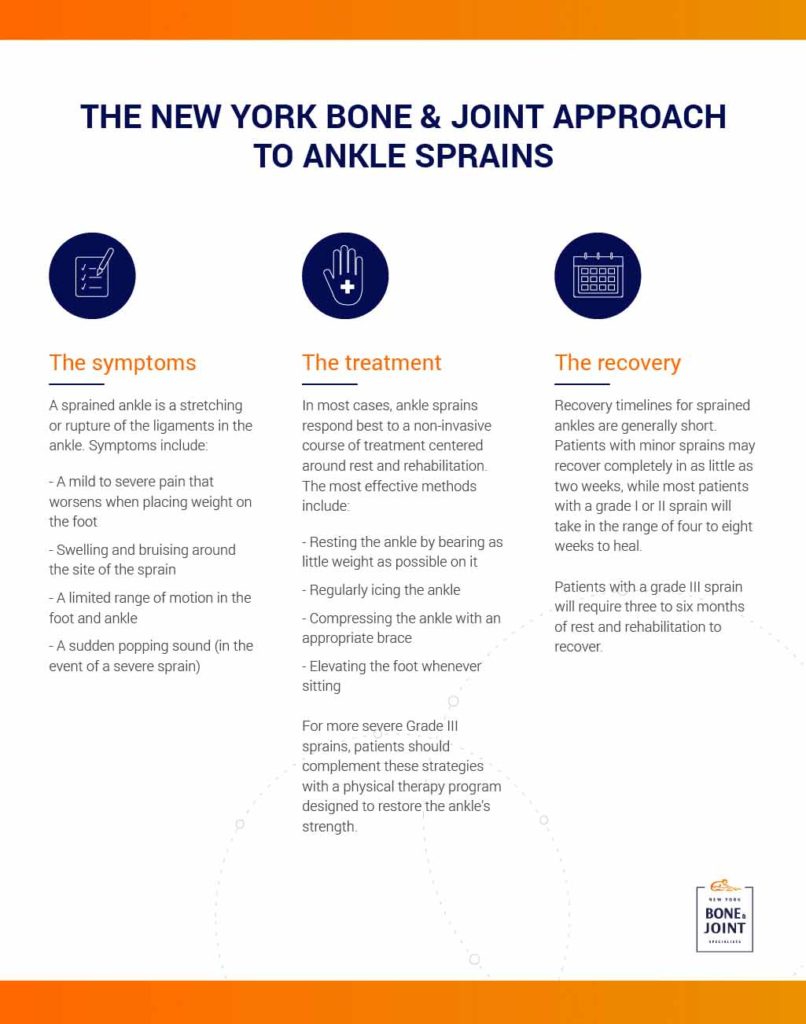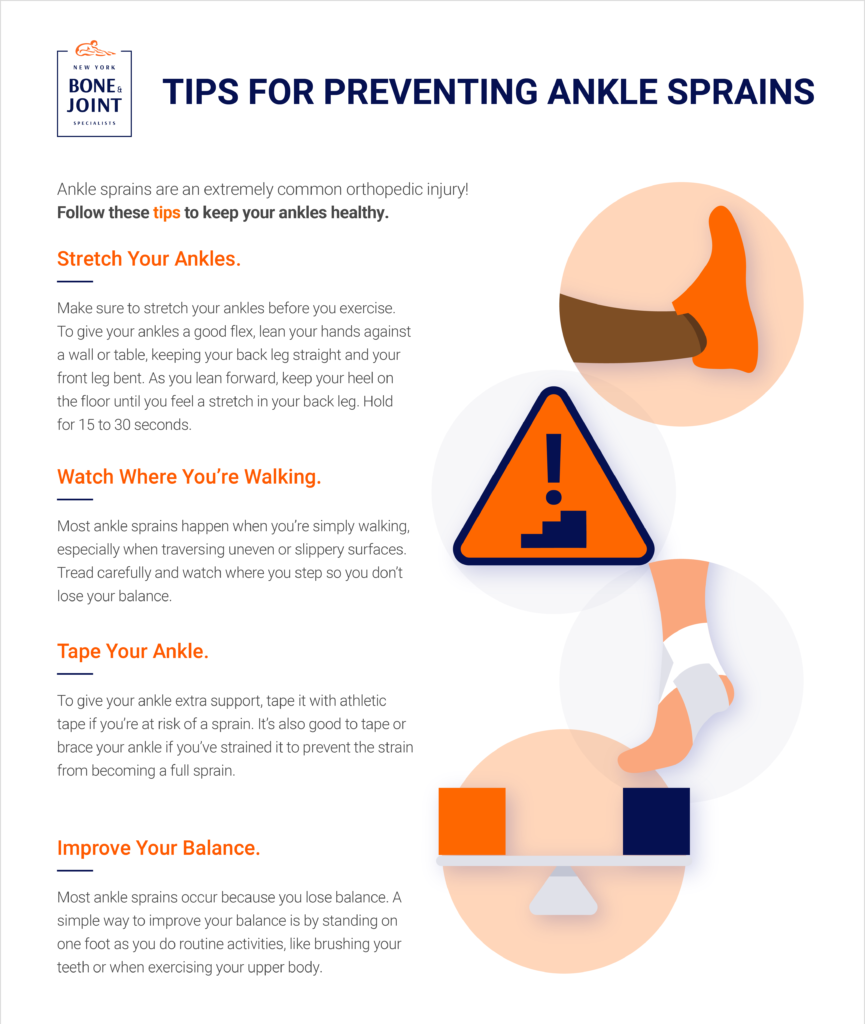Our New York ankle sprain doctors are here to help you recover from ankle injuries quickly and safely.
Ankle sprains are among the most common injuries affecting Americans, with thousands of people experiencing a sprained ankle every day across the United States.
At New York Bone & Joint Specialists, our experienced orthopedic doctors and ankle specialists provide comprehensive, evidence-based treatments to help you get back on your feet and return to the activities you love.
Whether you’ve rolled your ankle during your morning jog in Central Park, suffered a sports injury, or simply stepped off a curb wrong, sprains can be painful and disruptive to your daily life.
Our team understands the urgency of proper treatment and is here to provide expert care when you need it most. We’re consistently ranked among the best ankle specialists in NYC, and with offices located across the city, quality care is always within reach.
Let’s find out more about ankle sprains and what we can do to help.
What is an Ankle Sprain?
An ankle sprain occurs when the ligaments that support your ankle are stretched or torn beyond their normal range of motion. These ligaments are tough bands of tissue that connect bones to bones and help stabilize your ankle joint during movement.
Ankle sprains occur when your foot turns, twists, or rolls in an awkward way, forcing your ankle joint out of its normal position. This sudden movement can stretch or tear the ligaments, resulting in pain, swelling, and difficulty walking. While ankle sprains are common, they require proper medical attention to heal correctly and prevent long-term complications.
Our ankle sprain doctors understand that each injury is unique. We don’t just treat the immediate symptoms – we identify the underlying factors that contributed to your injury and develop a comprehensive treatment plan that promotes proper healing and reduces your risk of future ankle problems.
There are several ways to sprain your ankle, each with its own set of issues and recovery requirements. Let’s take a look.
Types of Ankle Sprains
Understanding the type of ankle sprain you have is crucial for proper treatment. We categorize these into several kinds:
Lateral Ankle Sprain – This is the most common type, accounting for almost all ankle sprains. It occurs when you roll your ankle inward, stretching or tearing the ligaments on the outside of your ankle. This typically happens when walking on uneven surfaces or during sports activities.
Medial Ankle Sprain – Less common but often more severe, this type affects the ligaments on the inside of your ankle. It usually occurs when your ankle rolls outward. This is less common due to the structure of the ankle bone, but can happen in rare occurrences.
High Ankle Sprain – Also called a syndesmotic sprain, a high ankle sprain affects the ligaments that connect the two bones of your lower leg (tibia and fibula) just above the ankle joint. High ankle sprains are more serious and typically take longer to heal than lateral ankle sprains. They often occur in contact sports or when the foot is planted and the leg rotates.
“A properly treated ankle sprain today prevents chronic instability and repeated injuries tomorrow. Our comprehensive rehabilitation program strengthens the supporting structures around your ankle to get you back on your feet with confidence.” – Dr. Leon Popovitz, MD, Co-Founder of New York Bone & Joint.
Sprained Ankle vs Broken Ankle: How to Tell the Difference
It’s not uncommon for people with sprained ankles to worry that they’re actually experiencing a broken bone. While both injuries can cause significant pain and swelling, there are important differences:
Signs of a Sprained Ankle:
- Pain that’s primarily around the ligaments and soft tissue
- Ability to bear some weight, though it may be painful
- Swelling and bruising around the ankle joint
- Tenderness when touching the injured ligaments
- Pain that may improve slightly with rest
Signs of a Broken Ankle:
- Severe pain that may be constant
- Inability to bear weight on the affected foot
- Visible deformity or bone protruding
- Numbness or tingling in the foot
- Severe swelling and bruising
- Pain that’s focused on the bone rather than soft tissue
If you’re unsure whether your ankle is sprained or broken, it’s always best to seek immediate medical attention. Our ankle specialists can perform the necessary examinations and imaging tests to provide an accurate diagnosis.

Should I Go to the Doctor for a Sprained Ankle?
Many people wonder if they need professional medical care for a sprained ankle. While minor sprains may heal with home care, you should see a sprained ankle doctor if you experience:
- Severe pain that doesn’t improve with rest and over-the-counter pain medication
- Inability to bear weight on the injured ankle
- Numbness or tingling in your foot
- Signs of infection (increased warmth, red streaking, fever)
- No improvement after 2-3 days of home care
- Recurring ankle sprains
- Concerns about whether your injury is a sprain or a fracture
Seeking professional sprained ankle treatment early can prevent complications and ensure proper healing. Our ankle specialists have the expertise to distinguish between different types of injuries and provide appropriate care.
How Do Our Ankle Specialists Diagnose Ankle Sprains?
Before beginning sprained ankle treatment, our team conducts a thorough evaluation to understand the extent of your injury and identify any underlying issues that may have contributed to the sprain.
We’ll begin by discussing your injury, including how it occurred, your symptoms, previous ankle injuries, and your activity level. After gathering this important background information, we may recommend several diagnostic tests to ensure we have a complete picture of your injury.
Physical Examination helps us assess the stability of your ankle joint, identify areas of tenderness, and evaluate your range of motion. Our specialists will gently test your ligaments for any sign of instability.
X-rays are typically the first imaging test we perform to rule out fractures. While X-rays don’t show soft tissue injuries like ligament tears, they’re essential for identifying broken bones that might alter your diagnosis.
MRI (Magnetic Resonance Imaging) provides detailed images of your ligaments, tendons, and other soft tissues. We may recommend an MRI for severe sprains, high ankle sprains, or when we suspect additional injuries to cartilage or other structures.
Ultrasound can be used to evaluate ligament integrity and guide injection treatments if needed. This imaging technique allows us to see your ligaments in real-time as you move your ankle.
Once we’ve completed our evaluation, we’ll explain your diagnosis clearly and work with you to develop a personalized treatment plan that fits your lifestyle and recovery goals.
Comprehensive Ankle Sprain Treatment in NYC
After diagnosing your ankle sprain, our specialists create a tailored treatment plan designed to reduce pain, restore function, and prevent future injuries.
For acute ankle sprains, we often recommend the RICE protocol as part of your initial treatment:
Rest – Avoiding activities that cause pain and giving your ankle time to heal
Ice – Applying ice for 15-20 minutes several times a day to reduce swelling
Compression – Using an ankle brace for sprain support to limit swelling and provide stability
Elevation – Keeping your ankle raised above heart level when possible to reduce swelling
Our ankle specialists may also recommend anti-inflammatory medications to help control pain and swelling during the initial healing phase.
Ankle bracing and support
An ankle brace for sprain recovery is often an important part of treatment. We may suggest various types of ankle support:
Elastic Bandages provide gentle compression and remind you to be careful with movement
Rigid Braces offer maximum support for severe sprains or during the return to activities
Functional Braces allow controlled movement while providing stability during healing
Custom Orthotics may be recommended for patients with recurring ankle sprains or underlying foot mechanics issues
Our specialists will help you choose the right type of ankle brace for your specific injury and activity level.
Physical Therapy
Physical therapy plays a crucial role in ankle sprain recovery and preventing future injuries. Our skilled physical therapists work closely with our ankle specialists to provide:
Early Mobility Exercises to prevent stiffness and maintain range of motion
Strengthening Programs targeting the muscles that support your ankle joint
Balance Training to improve your ankle’s ability to sense position and movement
Functional Movement Training to prepare you for return to sports and daily activities
Gait Training if your walking pattern has been affected by your injury.
Advanced Treatments
For severe sprains or cases that don’t respond to conservative treatment, we offer advanced options:
Platelet-Rich Plasma (PRP) Injections use your body’s own healing factors to promote ligament repair and reduce recovery time.
Corticosteroid Injections may be recommended for persistent inflammation that doesn’t respond to other treatments.
Minimally Invasive Procedures for severe ligament tears that may require surgical repair.
Types of Ankle Injuries We Treat
Our ankle specialists have extensive experience treating all types of ankle injuries and conditions:
Acute Ankle Sprains
From simple lateral sprains to complex high ankle sprains, we provide comprehensive care for all grades of ankle ligament injuries. Our treatment approach is tailored to the severity of your sprain and your individual recovery goals.
Chronic Ankle Instability
Repeated ankle sprains can lead to chronic instability, where your ankle frequently “gives way.” Here, we’ll work with you to improve ankle strength and balance.
High Ankle Sprains
These more complex injuries require specialized care due to their location and healing characteristics. Our specialists have extensive experience managing high ankle sprains and understand the unique challenges they present.
Peroneal Tendon Injuries
Often accompanying ankle sprains, peroneal tendon injuries can cause persistent pain and instability. We provide comprehensive evaluation and treatment for these commonly overlooked injuries.
Ankle Fractures
When your rolled ankle is actually broken, our orthopedic specialists provide expert fracture care, from simple fractures that can be treated with casting to complex injuries requiring surgical intervention.
Achilles Tendon Injuries
Ankle sprains can sometimes involve the Achilles tendon. Our specialists are experienced in diagnosing and treating these injuries to ensure complete recovery.

Why Choose New York Bone & Joint Specialists for ankle sprains?
For decades, New York Bone and Joint Specialists has been the trusted choice in the Big Apple for healing sprained ankles. Here’s why:
- Our pain management doctors are board-certified specialists with extensive training in the latest pain management techniques and technologies.
- With multiple locations throughout New York, expert pain management care is always accessible.
- We work with most major insurance plans to make quality pain management care affordable and accessible.
- From diagnosis through treatment and rehabilitation, we provide complete pain management services without the need for multiple referrals.
- Our evidence-based approach has helped thousands of New Yorkers achieve significant pain relief and improved quality of life.
Our top-rated ankle sprain specialists in NYC
At New York Bone & Joint Specialists, our concern is the well-being of our patients. Our team of highly skilled physicians, surgeons, physical therapists, and support staff works collaboratively to provide exceptional care and peace of mind, focusing on the sustained health and effective management of both chronic and acute ankle sprains.
Our in-house ankle sprain experts, recognized nationally for their extensive accreditations, publications, and knowledge, are available to meet with you.
Make an appointment today
Start your recovery today. Book your appointment with New York Bone & Joint Specialists now.
BOOK AN APPOINTMENT BUTTON
Ankle Sprain Treatment: Frequently Asked Questions
How long does it take for a sprained ankle to heal?
Recovery time varies depending on the severity of your sprain. Grade 1 (mild) sprains typically heal within 2-4 weeks, Grade 2 (moderate) sprains may take 4-6 weeks, and Grade 3 (severe) sprains can take 6-12 weeks or longer.
High ankle sprains generally take longer to heal than lateral ankle sprains. Following your treatment plan and attending physical therapy can help optimize your recovery time.
Can I walk on a sprained ankle?
This depends on the severity of your injury. With mild sprains, you may be able to walk with some discomfort, but severe sprains may make walking impossible.
If you can’t bear weight or walking causes severe pain, you should seek immediate medical attention. Your ankle specialist will provide specific weight-bearing instructions based on your injury.
Do I need an ankle brace for my sprain?
Most ankle sprains benefit from some form of bracing or support during the healing process. An ankle brace for sprain recovery can provide stability, reduce swelling, and prevent re-injury. Your specialist will recommend the appropriate type of brace based on your injury severity and activity level.
When should I start physical therapy after an ankle sprain?
Physical therapy typically begins once acute pain and swelling have decreased, usually within a few days to a week after injury for mild sprains. For severe sprains, therapy may be delayed until more healing has occurred. Early, appropriate movement is important for proper healing and preventing stiffness.
How can I prevent future ankle sprains?
Prevention strategies include maintaining good ankle strength and flexibility, wearing appropriate footwear for your activities, being aware of walking surfaces, and using ankle braces during high-risk activities if you have a history of ankle sprains. Our specialists can provide personalized prevention strategies based on your risk factors.
What’s the difference between a high ankle sprain and a regular ankle sprain?
A high ankle sprain affects the ligaments connecting the two bones of your lower leg (syndesmosis), while a regular lateral ankle sprain affects the ligaments on the outside of your ankle joint.
High ankle sprains are less common but typically more severe and take longer to heal. They often occur when the foot is planted and the leg rotates, common in contact sports.
Should I use heat or ice for my sprained ankle?
Ice is generally recommended for the first 48-72 hours after injury to reduce swelling and pain. Apply ice for 15-20 minutes at a time, several times per day. After the acute phase, gentle heat may help with stiffness and blood flow. Your healthcare provider will give you specific instructions based on your injury.











